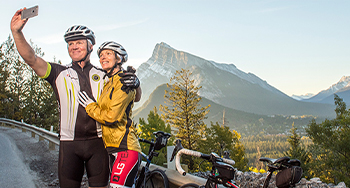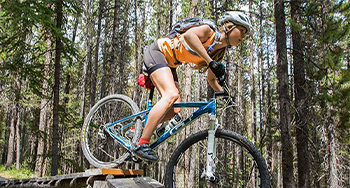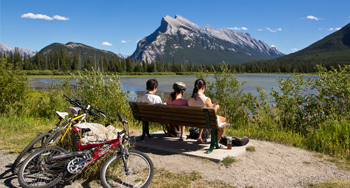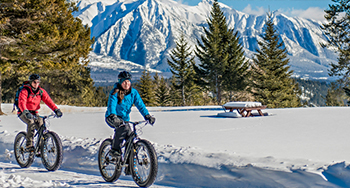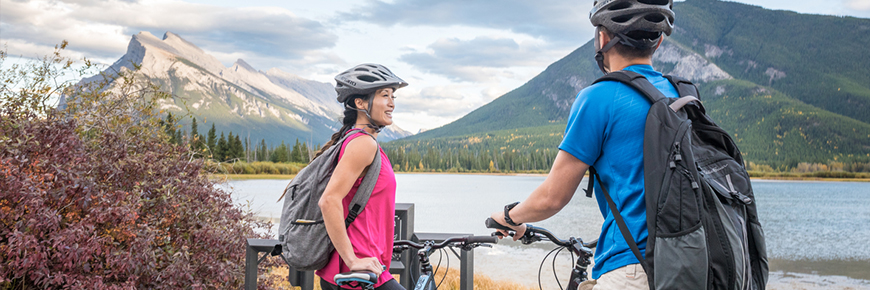
With more than 190 km of mountain bike trails and numerous road riding options, biking is an excellent way to explore Banff National Park. Trails range from easy to difficult.
Where to Bike
Banff National Park encourages the use of bikes for the appreciation and enjoyment of the park’s spectacular landscape of rugged mountains, broad valleys, glaciers, alpine meadows and wildlife species.
- Cycling on the Bow Valley Parkway
- Banff Legacy Trail
- Banff Road Rides
- Banff Mountain Biking Trails
- Lake Louise Road Rides
- Lake Louise Mountain Biking Trails
- E-biking
Cycling Brochures (Printable version)
If your objective is freeriding or downhilling, please consider areas such as Golden or Fernie, BC or Canada Olympic Park in Calgary, where these activities are both appropriate and encouraged.
Rules and regulations
Be a mountain park steward, ride with care!
Riding non-designated or closed trails, building new trails, or riding off-trail displaces wildlife and destroys soil and vegetation. These activities are also illegal and violators may be charged under the Canada National Parks Act.
- Ride designated trails. It is your responsibility to know where you can and cannot legally ride.
- Obey all traffic rules when riding on roads. At intersections, use hand signals to let drivers know which direction you will be travelling.
- On highways, ride as close as possible to the right-hand edge or curb. For your safety, it is recommended that you ride single file.
- Stay within the posted speed limits.
- Road closures, speed limits and traffic controls apply to bicyclists too. The Bow Valley Parkway Mandatory Seasonal Travel Restriction applies to all travel, including bicyclists. From March 1st to June 25th, travel is not permitted between 8 p.m. and 8 a.m. on the 17-kilometre section of the parkway from Johnston Canyon Campground to the Fireside Picnic Area. This is to ensure the area remains a high quality home for wildlife.
- Be visible when riding at dawn, dusk, or night. Always have a white front light and red rear and side reflectors and consider wearing reflective clothing.
- E-bikes are only permitted on roads and select trails in Banff National Park.
- Leave no trace. Be sure to pack out what you pack in – this includes all food and garbage. Leave natural and cultural objects undisturbed for others to discover.
- For the safety of wildlife, your pet and yourself, keep your dog on a leash and under physical control at all times.
- Do the right thing – protect wildlife. Littering, feeding animals or harassing wildlife is illegal and violators may be charged under the Canada National Parks Act.
Trail etiquette
- The bike trails in Banff National Park are all shared-use trails— expect to encounter hikers, vehicles and horseback riders. Ride in control and be ready to stop at any time.
- Always ride on the right, pass others on their left. If you are riding on a road with a sidewalk, stay on the road.
- Be courteous when passing other users. Use your voice or use a bell to let them know that you’ll be passing on their left so they have a chance to move over. Bicycles are fast and quiet, and can easily spook horses. When approaching oncoming horses, move to the side of the trail, stop and allow the horse party to pass. When passing horses from behind, slow down, let riders know of your presence before you get too close, and ask for instructions.
- Yield appropriately. Cyclists travelling downhill should yield to ones headed uphill.
- Avoid riding during extreme conditions. Wet, muddy or very dry trails are more likely to be damaged.
- Help preserve the quality of our trails. Ride, don’t slide— avoid skidding your tires by hard braking. Ride over obstacles, not around them. If obstacles are above your skill level, walk your bike.
Safety
You are responsible for your own safety. Be prepared for a breakdown or accident. Know how to repair your bike and carry the tools and parts to do so.
- Choose rides that match your abilities, experience, equipment and the time you have available. Be conservative—start with easier, shorter trip. Park Canada staff can help you select a suitable route.
- Ride within your limits. Inattention for even a moment could put yourself and others at risk.
- Wear a helmet and appropriate safety gear.
- Bring extra food, water and clothing. Surface water may be contaminated and unsafe for drinking. Mountain weather changes quickly and it can snow any month of the year.
- Always tell someone where you are going and when you plan to return.
- Travel with others and keep your group together.
- Avoid wearing earbuds. Be alert at all times.
- Ask for advice at a Parks Canada Visitor Centre about trail conditions, descriptions, and weather.
Wildlife and People
The Canadian Rocky Mountain national parks are home to wildlife, including elk, wolves, cougars, and the remaining grizzly and black bear populations in North America. To successfully raise their young and sustain a healthy population, wildlife need access to as much quality habitat with as few human surprises as possible.
Be aware of possible encounters with wildlife, even on roads and paved trails.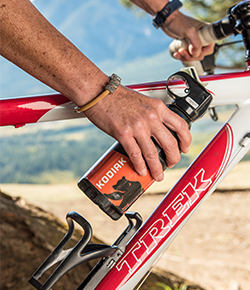
Tips:
- Carry bear spray with you at all times when on the trail and know how to use it.
- Slow down and make noise. Your speed and quietness puts you at risk for sudden bear encounters. Slow down through shrubby areas and when approaching blind corners. Travel in groups, be alert and always look ahead.
If you see a large carnivore, such as a bear, cougar, wolf or coyote, please report the sighting (when it is safe to do so) by calling Banff Dispatch at 1-403-762-1470.
Trail ratings
|
Easy Rides |
|
|
Moderate Rides |
|
|
|
|
- Date modified :
